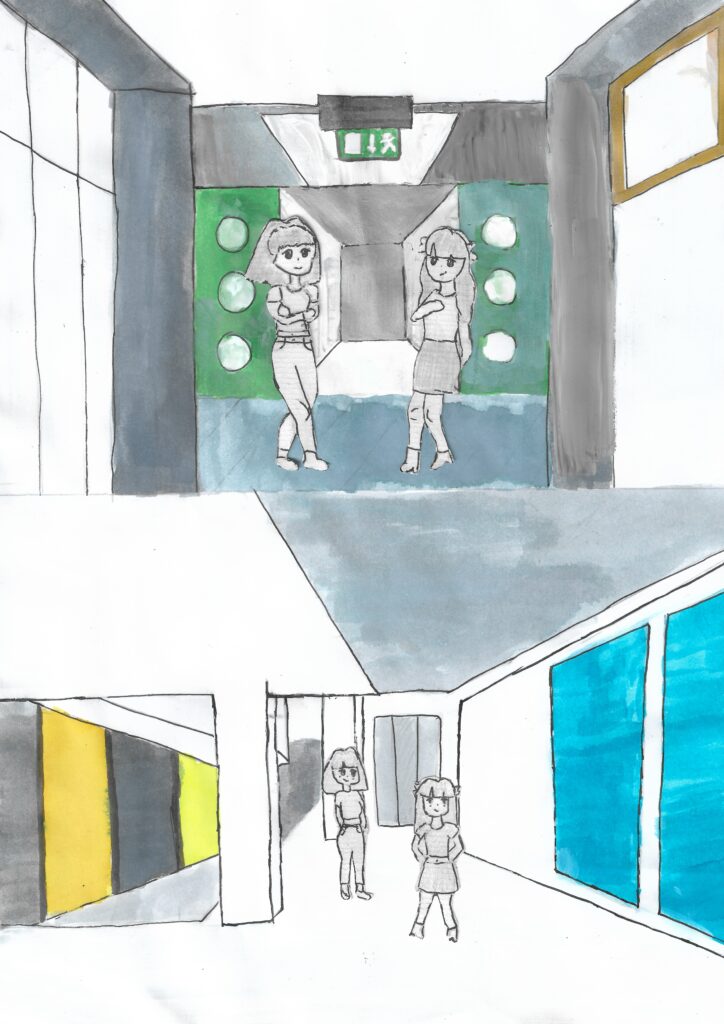By Maeve Bouchez
Edited by Katja Skylv
To bring an interactive twist to her first article of the year, my fellow Lux 1 journalist, Emma Vowles, either to her advantage or disadvantage, met me. Together, we explored the differences between our schools by doing a day exchange.
I followed Emma’s timetable. Quite naturally, I did not understand a word of Swedish biology, was absolutely baffled when she and her classmates pulled out computers and tablets in their L1 lesson (indeed, S5 students and above are required to have them for work matters), struggled less in her L2 German class, and stayed in the library whilst she took a history test.
When asked to describe their school, what came up most frequently amongst Lux 1 students was “prison,” “juvenile detention centre,” “asylum,” “depressing,” and “old”. This especially applies to the school’s crumbling exterior and its need for more scaffolding. Nonetheless, Lux 1’s easy access by public transport makes up for it.
Regardless of the somewhat pejorative remarks about the school’s physical appearance, its internationality was equally praised. The same can obviously be said for Lux 2, but both schools balance themselves out in terms of language sections. Although the English, French, and German ones remain the most popular, Kirchberg also enrols Dutch, Finnish, Polish, Portuguese, Spanish, and Swedish-speaking students. Additionally, it has opened SWALS Bulgarian, Estonian, Latvian, and Lithuanian classes, and a Ukrainian section has been created that admits young Ukrainian refugees. The school’s interior upkeep is relatively good too, apart from the inevitable vandalism in bathroom cubicles.

Provided a new pupil were to try to orient themselves alone around Lux 1, it would probably be confusing. Its layout is not as straightforward, or so it seemed in my experience. Lockers are scattered all over the place, and room numbers do not adhere to logic. There are two gym halls, and swimming lessons are taught at d’Coque. Due to the secondary building’s big L-shaped architecture, five minutes between classes is barely enough to sprint from one end of the school to the other. School hours also slightly differ: the day finishes at 16h25, the twenty-minute break occurs after third period, and lunch, only during fifth and sixth.
Supplied by Sodexo, Lux 1’s canteen has five food stands: the main meat or fish-based dish is served at Côté Bistro; Bowl tends to ramen; Pasta Roma is for Italian cuisine lovers; barbecues and burgers can be found at Streat Food, and Natural has all vegetarians covered. Similarly to our own in Mamer, the Kirchberg cafeteria offers sandwiches, salads, pastries, drinks, and snacks. Prices average between six and seven euros depending on the starters and desserts added, and students use cards to pay. Unlike ours, the hall is equipped with microwaves for packed lunches to accommodate everyone.
What struck me most, however, upon entering the school’s dining hall, was how deinstitutionalised it presented itself. Picture a food court in a shopping centre with soaring ceilings and windows. Not only that, but parked outside around the corner of the building on Tuesdays, Wednesdays, and Fridays, the school has set up a food truck, whose unique menu items change daily. In both schools, the law of the jungle prevails during lunchtime. Still, I noticed less queue skipping in Kirchberg…
Concerning the mobile phone policy during the lunch break, students are not allowed to use their devices, let alone furtively glance at them to check the time. If caught by patrolling advisors, they will be confiscated.
Apparently, Lux 1’s kitchens were also proud to announce that some of their fruit and vegetables are harvested organically and directly from the school’s gardens. The legitimacy of this claim is yet to be attested, though, since Emma reported never having seen them. Even so, aside from dubious vegetable patches and fruit orchards, Kirchberg has already developed and carried out many other sustainable initiatives. Back in June 2020, the school collaborated with Greenpeace and installed 1 500 photovoltaic panels on the main building’s roof! Recycling bins and water fountains have been widely deployed around the school as well.
Overall, my exchange went swimmingly. It involved a lot of me striding off confidently in the wrong direction, earning a few “Who the hell is that?” along the way, marvelling at the amount of food choice during lunch, subsequently gaping at the fees. Emma and her friends were all very welcoming and were even so kind as to warn me against visiting the notorious B-sector lavatories- a much-appreciated piece of advice, despite their whereabouts being unknown to me.
In conclusion, both schools can learn from each other. They are microcosms of the European Union, and the two promote EU values which fight for peace, freedom, and cultural diversity.
